Thiamine Supplementation Alleviates Lipopolysaccharide-Triggered Adaptive Inflammatory Response and Modulates Energy State via Suppression of NFκB/p38 MAPK/AMPK Signaling in Rumen Epithelial Cells of Goats
Abstract
1. Introduction
2. Materials and Methods
2.1. Reagents and Chemicals
2.2. Cell Culture
2.3. Experimental Design
2.4. Cell Viability
2.5. ELISA for IL-6 Concentrations
2.6. Apoptotic Cell Number Analysis by Flow Cytometry and Fluorescence Microscopy
2.7. Determination of ROS Content by Flow Cytometry and Fluorescence Microscopy
2.8. Mitochondrial Membrane Potential (MMP, ΔΨm) by Flow Cytometry and Fluorescence Microscopy
2.9. Immunofluorescence Staining
2.10. Analysis of Mitochondrial Morphology by Transmission Electron Microscope (TEM)
2.11. Mitochondrial DNA (mtDNA) Content Measurement
2.12. Measurement of Oxidative Stress Markers
2.13. ATP Determination
2.14. RT-PCR Analysis on Gene Expression
2.15. Western Blot Analysis
2.16. Cell Transfection
2.17. Statistical Analysis
3. Results
3.1. REC Viability with LPS and THI Treatments at Different Doses
3.2. THI Inhibits Apoptosis Induced by LPS in RECs
3.3. THI Inhibits OD Induced by LPS in RECs
3.4. THI Supplementation Maintains Mitochondrial Function in RECs
3.5. THI Supplementation Alleviates the Adaptive Response to Inflammation Induced by LPS and Promotes the Expression of THI Transporters in RECs
3.6. THI Supplementation Modulates Energy Metabolism Disturbance Induced by LPS in RECs
3.7. THI Supplementation Does Not Alleviate the Adaptive Response to Inflammation Induced by LPS in RECs under p38 Gene Overexpression
3.8. THI Supplementation Decreased Effects of Regulation in Energy Metabolism Disturbance Induced by LPS in RECs under p38 Gene Overexpression
4. Discussion
5. Conclusions
Supplementary Materials
Author Contributions
Funding
Institutional Review Board Statement
Informed Consent Statement
Data Availability Statement
Acknowledgments
Conflicts of Interest
References
- Plaizier, J.; Danesh, M.; Derakhshani, H.; Golder, H.; Khafipour, E.; Kleen, J.; Lean, I.; Loor, J.; Penner, G.; Zebeli, Q. Review: Enhancing gastrointestinal health in dairy cows. Animal 2018, 12, s399–s418. [Google Scholar] [CrossRef] [PubMed]
- Owens, F.; Secrist, D.; Hill, W.; Gill, D. Acidosis in cattle: A review. J. Anim. Sci. 1998, 76, 275–286. [Google Scholar] [CrossRef] [PubMed]
- Nagaraja, T.; Titgemeyer, E. Ruminal Acidosis in Beef Cattle: The Current Microbiological and Nutritional Outlook. J. Dairy Sci. 2007, 90, E17–E38. [Google Scholar] [CrossRef] [PubMed]
- Aschenbach, J.; Zebeli, Q.; Patra, A.; Greco, G.; Amasheh, S.; Penner, G. Symposium review: The importance of the ruminal epithelial barrier for a healthy and productive cow. J. Dairy Sci. 2019, 102, 1866–1882. [Google Scholar] [CrossRef] [PubMed]
- Khafipour, E.; Krause, D.; Plaizier, J. A grain-based subacute ruminal acidosis challenge causes translocation of lipopolysaccharide and triggers inflammation. J. Dairy Sci. 2009, 92, 1060–1070. [Google Scholar] [CrossRef]
- Zebeli, Q.; Ametaj, B. Relationships between rumen lipopolysaccharide and mediators of inflammatory response with milk fat production and efficiency in dairy cows. J. Dairy Sci. 2009, 92, 3800–3809. [Google Scholar] [CrossRef]
- Kent-Dennis, C.; Aschenbach, J.; Griebel, P.; Penner, G. Effects of lipopolysaccharide exposure in primary bovine ruminal epithelial cells. J. Dairy Sci. 2020, 103, 9587–9603. [Google Scholar] [CrossRef]
- Plaizier, J.; Khafipour, E.; Li, S.; Gozho, G.; Krause, D. Subacute ruminal acidosis (sara), endotoxins and health consequences–sciencedirect. Anim. Feed. Sci. Tech. 2012, 172, 9–21. [Google Scholar] [CrossRef]
- Ma, Y.; Elmhadi, M.; Zhang, Y.; Zhang, H.; Wang, H. Thiamine Alleviates High-Concentrate-Diet-Induced Oxidative Stress, Apoptosis, and Protects the Rumen Epithelial Barrier Function in Goats. Front. Vet. Sci. 2021, 8, 663698. [Google Scholar] [CrossRef]
- Ma, Y.; Wang, C.; Elmhadi, M.; Zhang, H.; Han, Y.; Shen, B.; Wang, H. Thiamine ameliorates metabolic disorders induced by a long-term high-concentrate diet and promotes rumen epithelial development in goats. J. Dairy Sci. 2021, 104, 11522–11536. [Google Scholar] [CrossRef]
- Ma, Y.; Elmhadi, M.; Wang, C.; Zhang, H.; Wang, H. Dietary supplementation of thiamine down-regulates the expression of mitophagy and endoplasmic reticulum stress-related genes in the rumen epithelium of goats during high-concentrate diet feeding. Ital. J. Anim. Sci. 2021, 20, 2220–2231. [Google Scholar] [CrossRef]
- Kurashima, Y.; Goto, Y.; Kiyono, H. Mucosal innate immune cells regulate both gut homeostasis and intestinal inflammation. Eur. J. Immunol. 2013, 43, 3108–3115. [Google Scholar] [CrossRef] [PubMed]
- Ulivi, V.; Giannoni, P.; Gentili, C.; Cancedda, R.; Descalzi, F. p38/NF-kB-dependent expression of COX-2 during differentiation and inflammatory response of chondrocytes. J. Cell. Biochem. 2008, 104, 1393–1406. [Google Scholar] [CrossRef]
- Bonilla-Porras, A.; Jimenez-Del-Rio, M.; Velez-Pardo, M. Vitamin K3 and vitamin Calone or in combination induced apoptosis in leukemia cells by a similar oxidative stress signalling mechanism. Cancer Cell Int. 2011, 10, 11–19. [Google Scholar]
- Zhang, G.; Zhang, T.; Jin, Y.; Liu, J.; Guo, Y.; Fan, Y. Effect of caloric restriction and subsequent re-alimentation on oxidative stress in the liver of Hu sheep ram lambs. Anim. Feed. Sci. Technol. 2018, 237, 68–77. [Google Scholar] [CrossRef]
- Nozaki, S.; Mizuma, H.; Tanaka, M.; Jin, G.; Tahara, T.; Mizuno, K. Thiamine tetrahydrofurfuryl disulfide improves energy metabolism and physical performance during physical-fatigue loading in rats. Nutr. Res. 2009, 29, 867–872. [Google Scholar] [CrossRef] [PubMed]
- Hernandez-Vazquez, A.; Garcia-Sanchez, J.; Moreno-Arriola, E.; Salvador-Adriano, A.; Ortega-Cuellar, D.; Velazquez-Arellano, A. Thiamine deprivation produces a liver ATP deficit and metabolic and genomic effects in mice: Findings are parallel to those of biotin deficiency and have implications for energy disorders. Lifestyle. Genom. 2016, 9, 287–299. [Google Scholar] [CrossRef]
- Dhir, S.; Tarasenko, M.; Napoli, E.; Giulivi, C. Neurological, Psychiatric and Biochemical Aspects of Thiamine Deficiency in Children and Adults. Front. Psychiatry 2019, 10, 207. [Google Scholar] [CrossRef]
- Hardie, D.; Carling, D.; Carlson, M. The AMP-activated/SNF1 protein kinase subfamily: Metabolic sensors of the eukaryotic cell. Annu. Rev. Biochem. 1998, 67, 821–855. [Google Scholar] [CrossRef]
- Velazquez-Arellano, A.; Hernandez-Vazquez, A. Vitamins as Cofactors for Energy Homeostasis and Their Genomic Control, With Special Reference to Biotin, Thiamine, and Pantothenic Acid. In Principles of Nutrigenetics and Nutrigenomics; Academic Press: Cambridge, MA, USA, 2020; pp. 271–277. [Google Scholar] [CrossRef]
- Zhao, Y.; Pan, X.; Zhao, J.; Wang, Y.; Peng, Y.; Zhong, C. Decreased transketolase activity contributes to impaired hippocampal neurogenesis induced by thiamine deficiency. J. Neurochem. 2009, 111, 537–546. [Google Scholar] [CrossRef]
- Pan, X.; Yang, L.; Beckers, Y.; Xue, F.; Tang, Z.; Jiang, L.; Xiong, B. Thiamine supplementation facilitates thiamine transporter expression in the rumen epithelium and attenuates high-grain-induced inflammation in low-yielding dairy cows. J. Dairy Sci. 2017, 100, 5329–5342. [Google Scholar] [CrossRef] [PubMed]
- Zhang, H.; Peng, A.; Zhao, F.; Yu, L.; Wang, M.; Osorio, J.; Wang, H. Thiamine ameliorates inflammation of the ruminal epithelium of Saanen goats suffering from subacute ruminal acidosis. J. Dairy Sci. 2020, 103, 1931–1943. [Google Scholar] [CrossRef] [PubMed]
- Brent, B. Relationship of acidosis to other feedlot ailments. J. Anim. Sci. 1976, 43, 930–935. [Google Scholar] [CrossRef] [PubMed]
- Gálfi, P.; Neogrady, S.; Kutas, F. Culture of epithelial cells from bovine ruminal mucosa. Vet. Res. Commun. 1980, 4, 295–300. [Google Scholar] [CrossRef] [PubMed]
- Gao, J.; Xu, Q.; Wang, M.; Ouyang, J.; Tian, W.; Feng, D.; Loor, J. Ruminal epithelial cell proliferation and short-chain fatty acid transporters in vitro are associated with abundance of period circadian regulator 2 (PER2). J. Dairy. Sci. 2020, 103, 12091–12103. [Google Scholar] [CrossRef]
- Liu, J.; Timm, D.; Hurley, T. Pyrithiamine as a substrate for thiamine pyrophosphokinase. J. Biol. Chem. 2006, 281, 6601–6607. [Google Scholar] [CrossRef]
- Graham, C.; Simmons, N. Functional organization of the bovine rumen epithelium. Am. J. Physiol.-Reg. I. 2005, 288, R173–R181. [Google Scholar] [CrossRef]
- Zhang, G.; Deng, Y.; Zhang, Y.; Fan, Y.; Wan, H.; Nie, Z.; Wang, F.; Lei, Z. Effect of PGC-1α over-expression or silencing on mitochondrial apoptosis of goat luteinized granulosa cells. J. Bioenerg. Biomembr. 2016, 48, 493–507. [Google Scholar] [CrossRef]
- Zhang, H.; Zhao, F.; Peng, A.; Guo, S.; Wang, M.; Elsabagh, M.; Wang, H. L-Arginine Inhibits Apoptosis of Ovine Intestinal Epithelial Cells through the l-Arginine–Nitric Oxide Pathway. J. Nutr. 2020, 150, 2051–2060. [Google Scholar] [CrossRef]
- Xing, X.; Jiang, X.; Tang, P.; Wang, Y.; Li, Y.; Sun, G.; Zou, S. Sodium butyrate protects against oxidative stress in HepG2 cells through modulating Nrf2 pathway and mitochondrial function. J. Physiol. Biochem. 2016, 73, 405–414. [Google Scholar] [CrossRef]
- Gao, D.; Xu, Z.; Zhang, X.; Wang, H.; Wang, Y.; Min, W. Molecular cloning, immunohistochemical localization, characterization and expression analysis of caspase-9 from the purse red common carp (Cyprinus carpio) exposed to cadmium. Aqua. Toxicol. 2013, 142, 53–62. [Google Scholar] [CrossRef] [PubMed]
- Livak, K.; Schmittgen, T. Analysis of relative gene expression data using real-time quantitative PCR and the 2−ΔΔCT method. Methods 2001, 25, 402–408. [Google Scholar] [CrossRef] [PubMed]
- Cheng, J.; Zhang, Y.; Ge, Y.; Li, W.; Cao, Y.; Qu, Y.; Liu, J. Sodium butyrate promotes milk fat synthesis in bovine mammary epithelial cells via GPR41 and its downstream signalling pathways. Life Sci. 2020, 259, 118375. [Google Scholar] [CrossRef] [PubMed]
- Chang, G.; Zhuang, S.; Seyfert, H.; Zhang, K.; Xu, T.; Jin, D.; Guo, J.; Shen, X. Hepatic TLR4 signaling is activated by LPS from digestive tract during SARA, and epigenetic mechanisms contribute to enforced TLR4 expression. Oncotarget 2015, 6, 38578–38590. [Google Scholar] [CrossRef] [PubMed]
- Manuel, D.; Madsen, K.; Churchill, T.; Dunn, S.; Ametaj, B. Acidosis and lipopolysaccharide from Escherichia coli B:055 cause hyperpermeability of rumen and colon tissues. J. Dairy Sci. 2007, 90, 5552–5557. [Google Scholar] [CrossRef]
- Pan, X.; Yang, L.; Xue, F.; Xin, H.; Jiang, L.; Xiong, B.; Beckers, Y. Relationship between thiamine and subacute ruminal acidosis induced by a high-grain diet in dairy cows. J. Dairy Sci. 2016, 99, 8790–8801. [Google Scholar] [CrossRef]
- Pan, X.; Xue, F.; Nan, X.; Tang, Z.; Wang, K.; Beckers, Y.; Xiong, B. Illumina sequencing approach to characterize thiamine metabolism related bacteria and the impacts of thiamine supplementation on ruminal microbiota in dairy cows fed high-grain diets. Front. Microbiol. 2017, 8, 1818. [Google Scholar] [CrossRef]
- Zhu, E.; Fang, L.; Subramanian, V.; Said, H.; Sassoon, C. Lipopolysaccharide and cytokines inhibit thiamine uptake and thiamine transporter gene expression in C2c12 myoblasts. Am. J. Respir. Crit. Care Med. 2015, 191, 4361. [Google Scholar]
- Fan, J.; Feng, G.; Huang, L.; Tang, G.; Jiang, H.; Xu, J. Naofen promotes TNF-alpha-mediated apoptosis of hepatocytes by activating caspase-3 in lipopolysaccharide-treated rats. World. J. Gastroenterol. 2014, 20, 4963–4971. [Google Scholar] [CrossRef]
- Li, J.; Yuan, J. Caspases in apoptosis and beyond. Oncogene 2008, 27, 6194–6206. [Google Scholar] [CrossRef]
- Campbell, K.; Rocha, S.; Perkins, N. Active Repression of Antiapoptotic Gene Expression by RelA(p65) NF-kB. Mol. Cell. 2004, 13, 853–865. [Google Scholar] [CrossRef]
- Lee, J.; Jung, W.; Jeong, M.; Yoon, T.; Kim, H. Sanguinarine induces apoptosis of HT-29 human colon cancer cells via the regulation of Bax/Bcl-2 ratio and caspase-9-dependent pathway. Int. J. Toxicol. 2012, 31, 70–77. [Google Scholar] [CrossRef] [PubMed]
- Zhang, H.; Ma, Y.; Wang, M.; Elsabagh, M.; Loor, J.; Wang, H. Dietary supplementation of l-arginine and N-carbamylglutamate enhances duodenal barrier and mitochondrial functions and suppresses duodenal inflammation and mitophagy in suckling lambs suffering from intrauterine-growth-restriction. Food. Funct. 2020, 11, 4456–4470. [Google Scholar] [CrossRef] [PubMed]
- Li, X.; Zhou, A.; Li, X. Inhibition ofLycium barbarum polysaccharides andGanoderma lucidumpolysaccharides against oxidative injury induced by γ-irradiation in rat liver mitochondria. Carbohyd. Polym. 2007, 69, 172–178. [Google Scholar] [CrossRef]
- Strandberg, Y.; Gray, C.; Vuocolo, T.; Donaldson, L.; Broadway, M.; Tellam, R. Lipopolysaccharide and lipoteichoic acid induce different innate immune responses in bovine mammary epithelial cells. Cytokine 2005, 31, 72–86. [Google Scholar] [CrossRef]
- Lee, S. Intestinal permeability regulation by tight junction: Implication on inflammatory bowel diseases. Intest. Res. 2015, 13, 11. [Google Scholar] [CrossRef]
- Kowaltowski, A.; De-Souza-Pinto, N.; Castilho, R.; Vercesi, A. Mitochondria and reactive oxygen species. Free Radic. Biol. Med. 2009, 47, 333–343. [Google Scholar] [CrossRef]
- Cole-Ezea, P.; Swan, D.; Shanley, D.; Hesketh, J. Glutathione peroxidase 4 has a major role in protecting mitochondria from oxidative damage and maintaining oxidative phosphorylation complexes in gut epithelial cells. Free Radic. Biol. Med. 2012, 53, 488–497. [Google Scholar] [CrossRef]
- Amaral, M.; Ribeiro, R.; Vanzela, E.; Barbosa-Sampaio, H. Reduced AMPK alpha2 protein expression restores glucose-induced insulin secretion in islets from calorie-restricted rats. Int. J. Exp. Pathol. 2016, 97, 50–55. [Google Scholar] [CrossRef]
- Fernandez-Marcos, P.; Auwerx, J. Regulation of PGC-1a, a nodal regulator of mito-chondrial biogenesis. Am. J. Clin. Nutr. 2011, 93, 884S–890S. [Google Scholar] [CrossRef]
- Liang, H.; Ward, W. PGC-1α: A key regulator of energy metabolism. Adv. Physiol. Educ. 2006, 30, 145–151. [Google Scholar] [CrossRef] [PubMed]
- Hamano, Y.; Okada, S.; Tanaka, T. Effects of thiamine and clenbuterol on body composition, plasma metabolites and hepatic oxygen consumption in broiler chicks. Br. Poult. Sci. 1999, 40, 127–130. [Google Scholar] [CrossRef] [PubMed]
- Ye, J.; Zhu, N.; Sun, R.; Liao, W.; Fan, S.; Shi, F.; Ying, Y. Metformin inhibits chemokine expression through the AMPK/NF-κB signaling pathway. J. Interf. Cytok. Res. 2018, 38, 363–369. [Google Scholar] [CrossRef] [PubMed]
- Quivy, V.; Van Lint, C. Regulation at multiple levels of NF-kappaB-mediated transactivation by protein acetylation. Biochem. Pharmacol. 2004, 68, 1221–1229. [Google Scholar] [CrossRef]
- Saccani, S.; Pantano, S.; Natoli, G. p38-Dependent marking of inflammatory genes for increased NF-κB recruitment. Nat. Immunol. 2002, 3, 69–75. [Google Scholar] [CrossRef] [PubMed]
- Kefaloyianni, E.; Gaitanaki, C.; Beis, I. ERK1/2 and p38-MAPK signalling pathways, through MSK1, are involved in NF-κB transactivation during oxidative stress in skeletal myoblasts. Cell. Signal. 2006, 18, 2238–2251. [Google Scholar] [CrossRef]
- Chew, J.; Biswas, S.; Shreeram, S.; Humaidi, M.; Wong, E.; Dhillion, M.; Teo, H.; Hazra, A.; Fang, C.; Lopez-Collazo, E. WIP1 phosphatase is a negative regulator of NF-κB signalling. Nat. Cell. Biol. 2009, 11, 659–666. [Google Scholar] [CrossRef]
- Cheng, Z.; Pang, T.; Gu, M.; Gao, A.; Xie, C.; Li, J. Berberine-stimulated glucose uptake in L6 myotubes involves both AMPK and p38 MAPK. BBA-GEN. Subjects 2006, 1760, 1682–1689. [Google Scholar] [CrossRef]
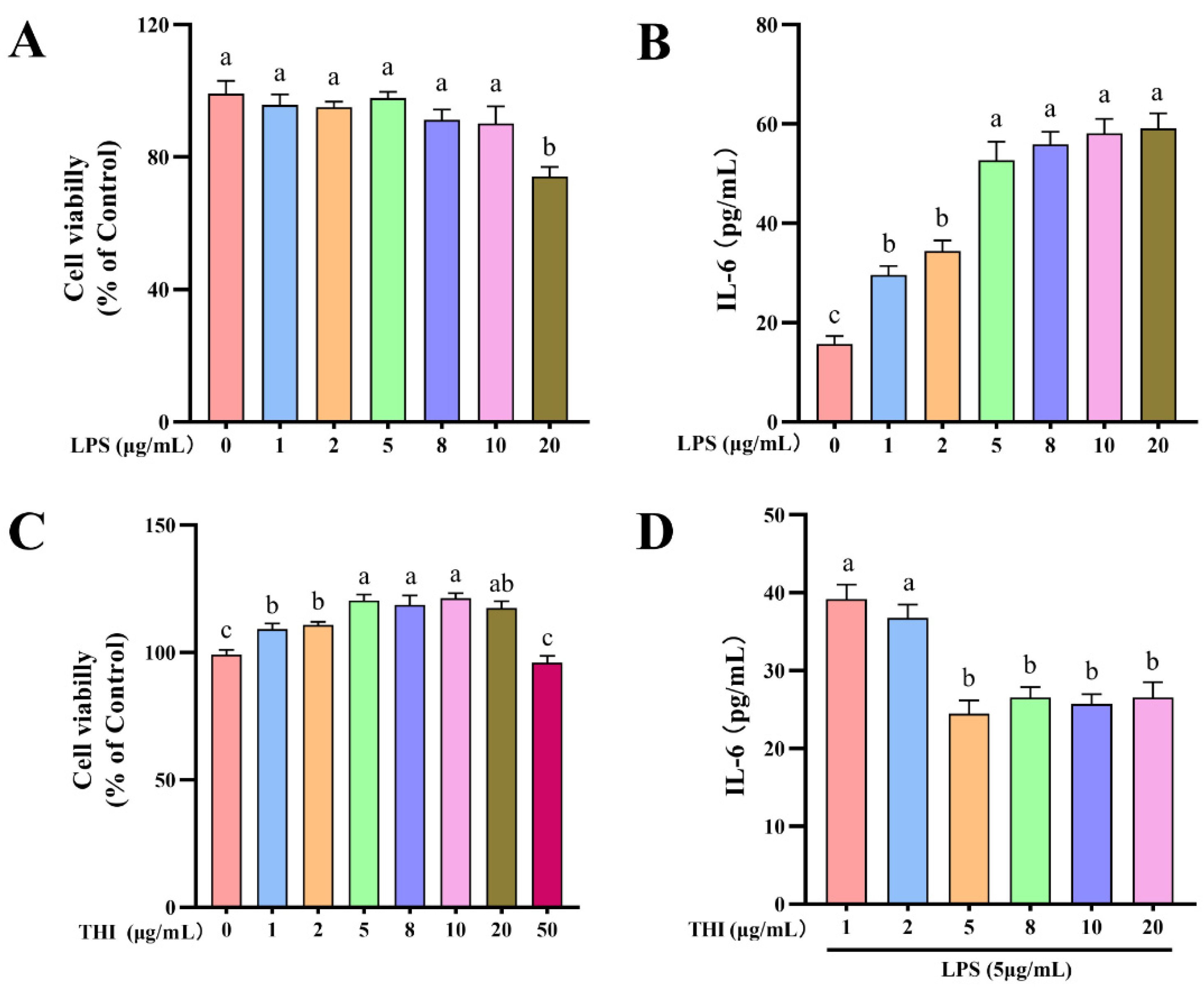
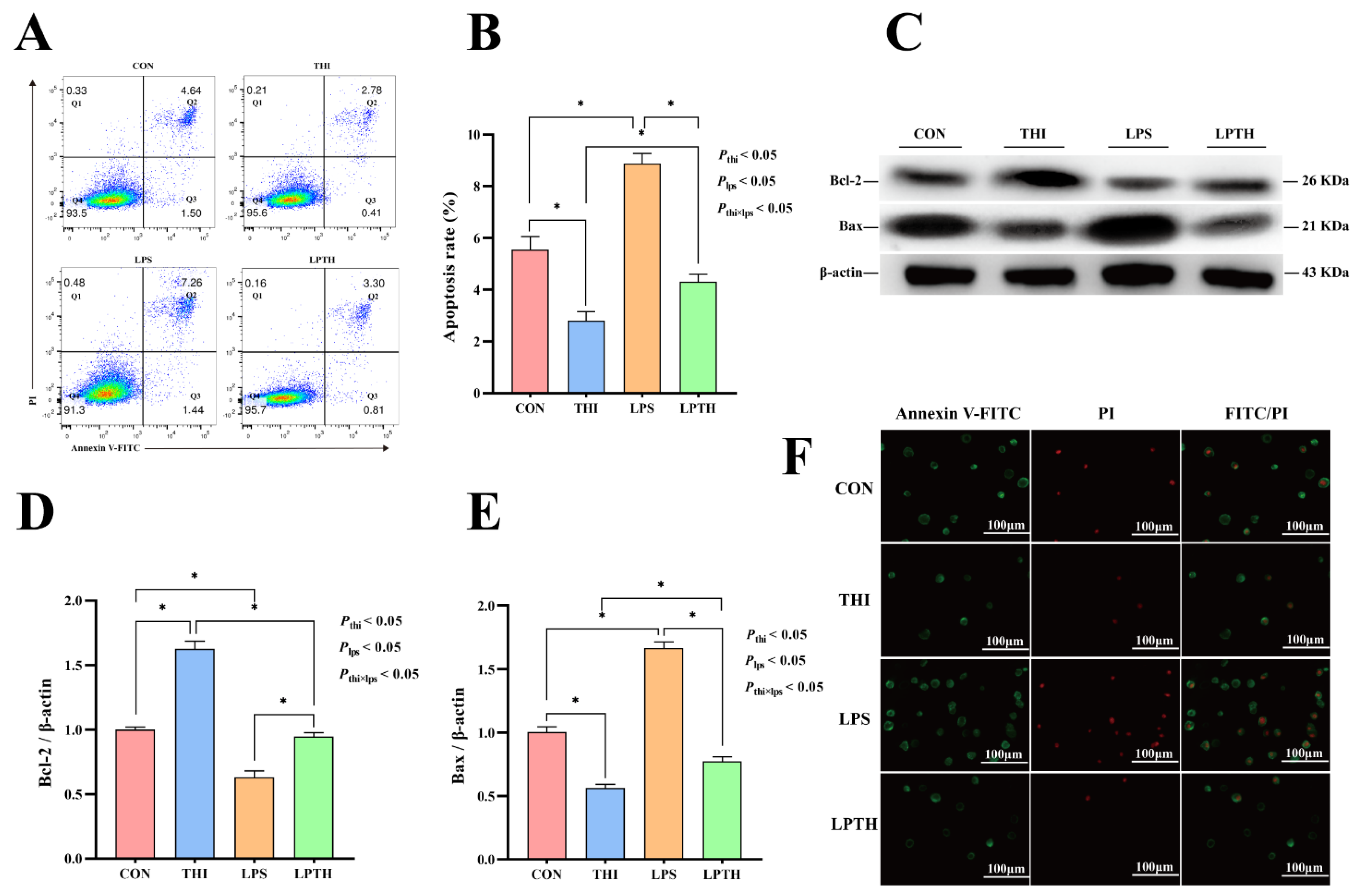

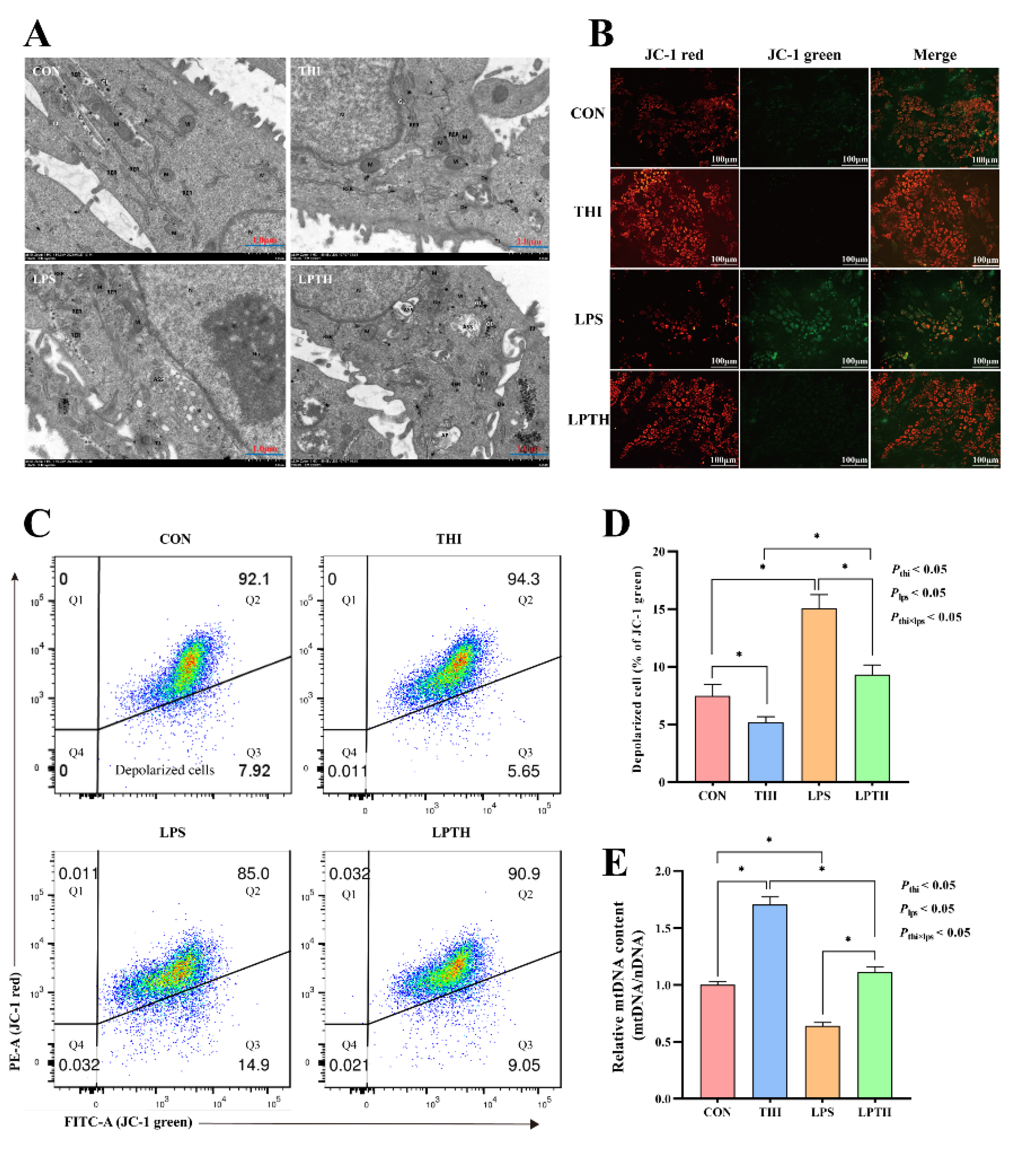
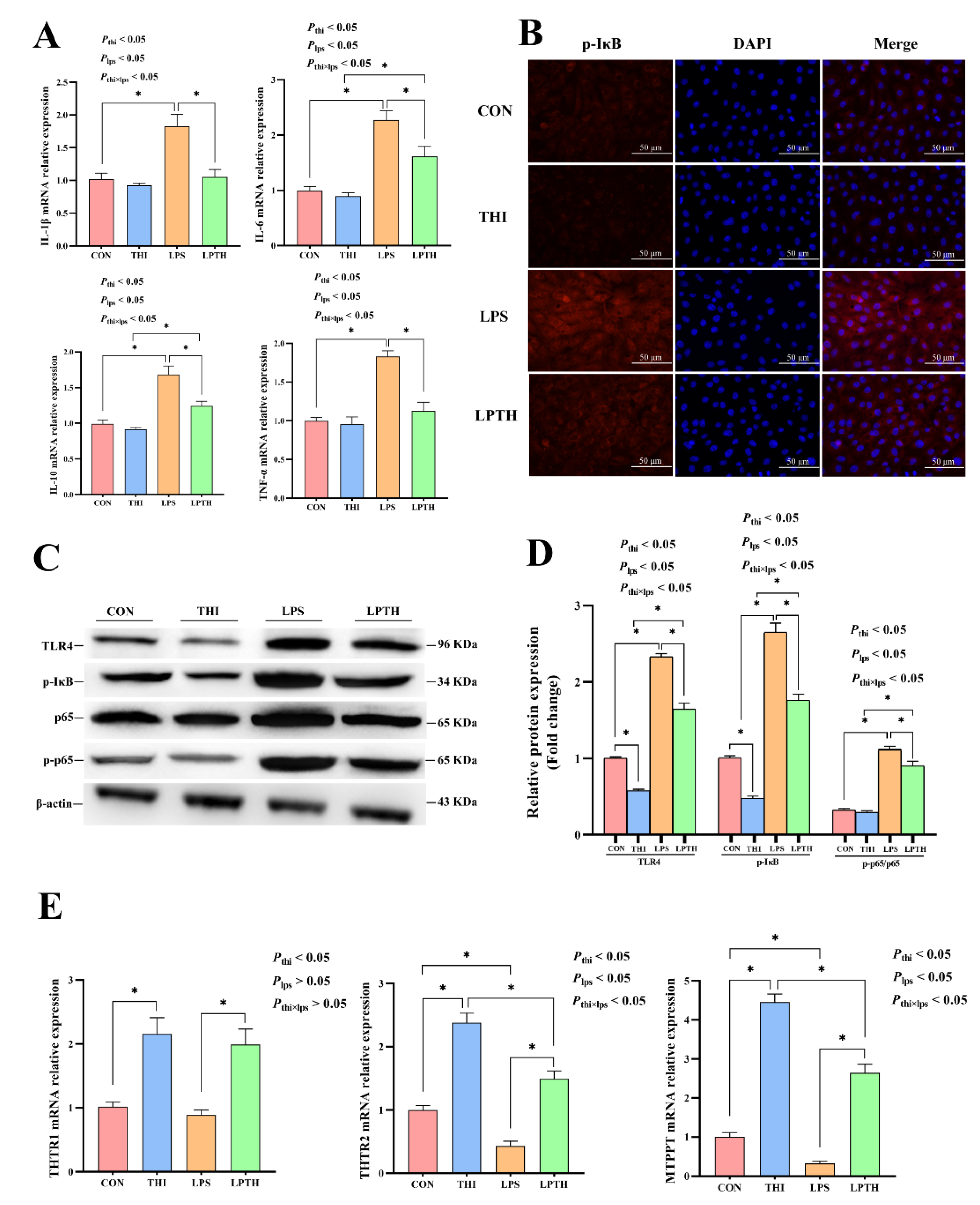
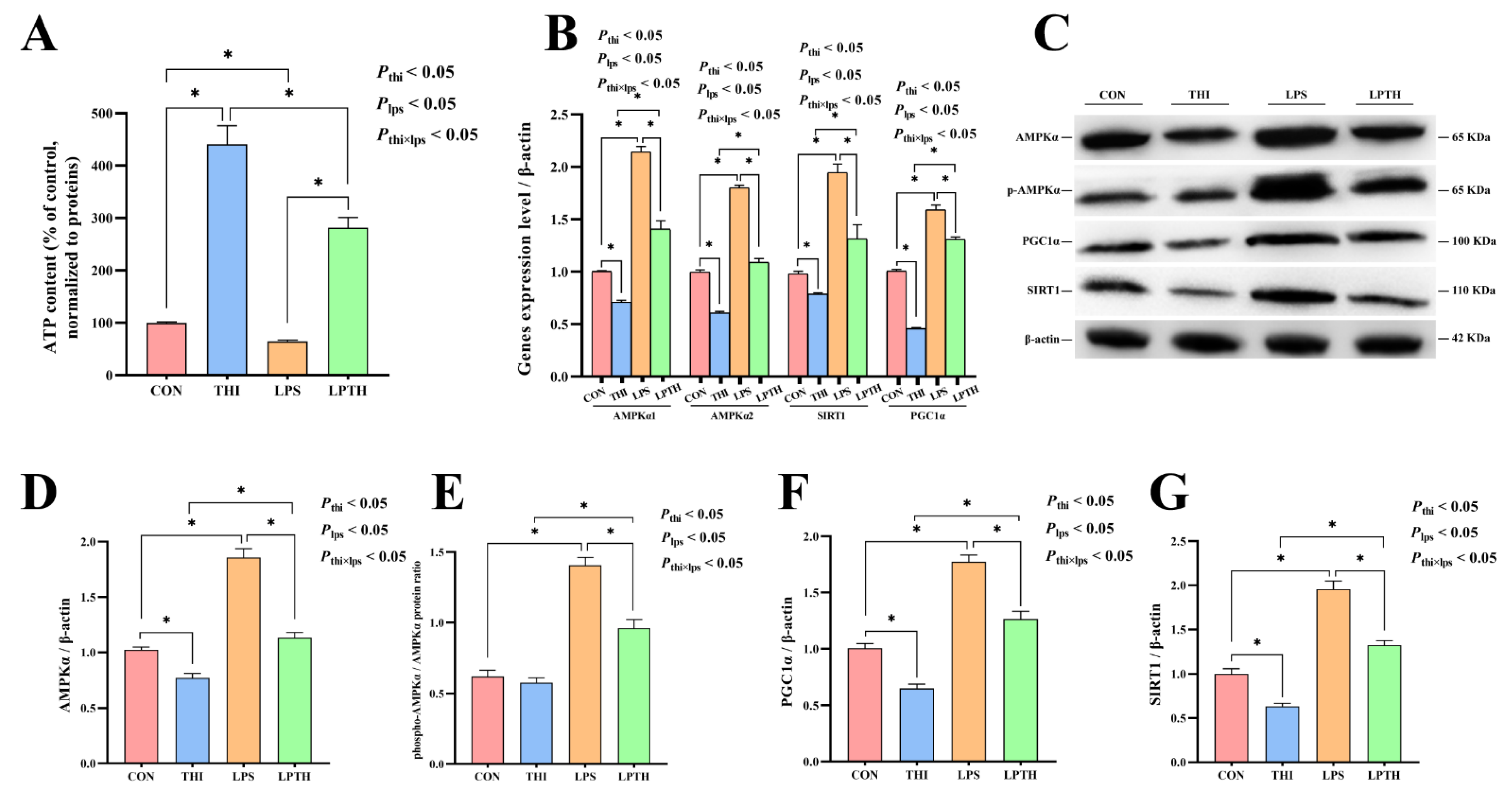


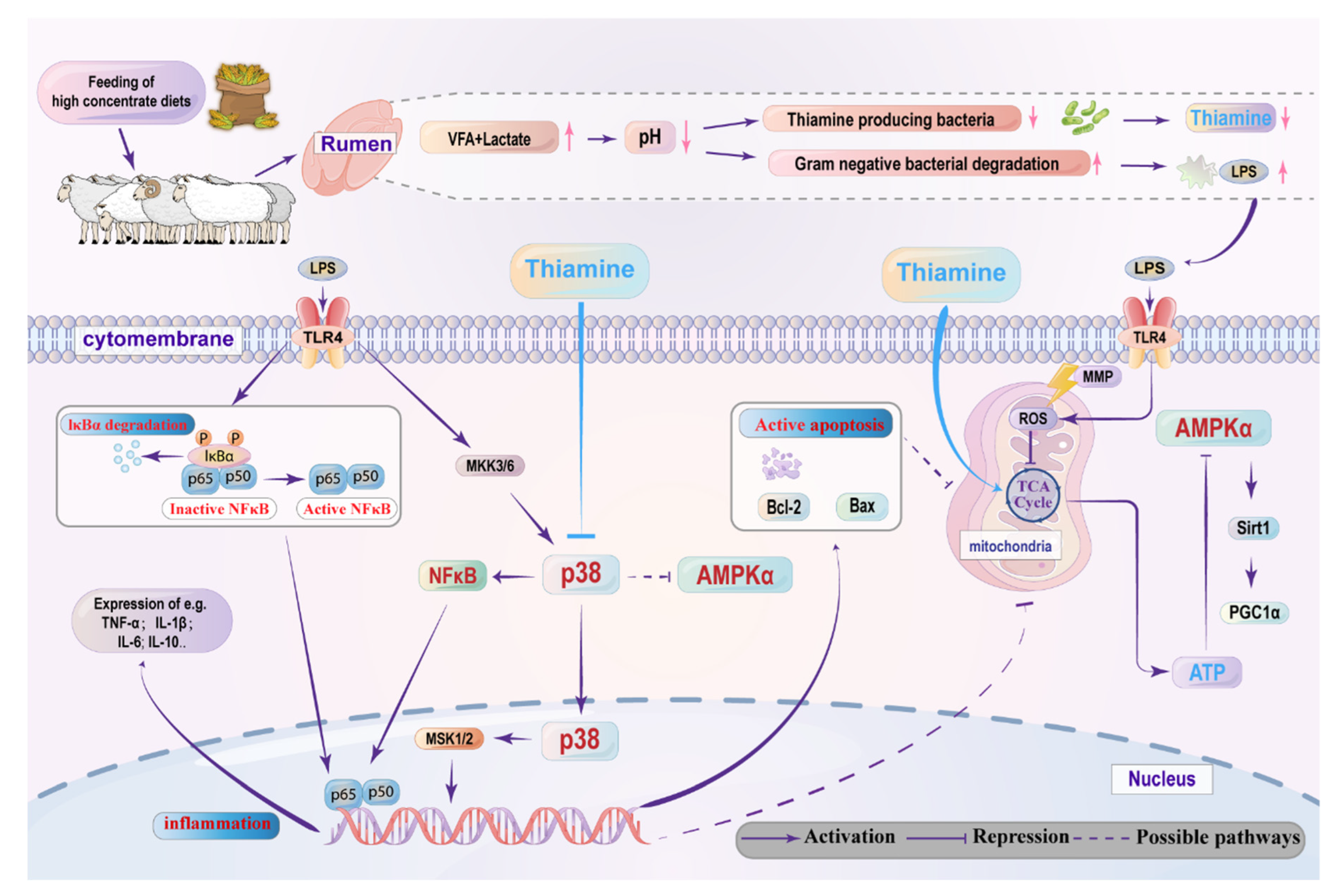
Publisher’s Note: MDPI stays neutral with regard to jurisdictional claims in published maps and institutional affiliations. |
© 2022 by the authors. Licensee MDPI, Basel, Switzerland. This article is an open access article distributed under the terms and conditions of the Creative Commons Attribution (CC BY) license (https://creativecommons.org/licenses/by/4.0/).
Share and Cite
Ma, Y.; Elmhadi, M.; Wang, C.; Li, Z.; Zhang, H.; He, B.; Zhao, X.; Zhang, Z.; Wang, H. Thiamine Supplementation Alleviates Lipopolysaccharide-Triggered Adaptive Inflammatory Response and Modulates Energy State via Suppression of NFκB/p38 MAPK/AMPK Signaling in Rumen Epithelial Cells of Goats. Antioxidants 2022, 11, 2048. https://doi.org/10.3390/antiox11102048
Ma Y, Elmhadi M, Wang C, Li Z, Zhang H, He B, Zhao X, Zhang Z, Wang H. Thiamine Supplementation Alleviates Lipopolysaccharide-Triggered Adaptive Inflammatory Response and Modulates Energy State via Suppression of NFκB/p38 MAPK/AMPK Signaling in Rumen Epithelial Cells of Goats. Antioxidants. 2022; 11(10):2048. https://doi.org/10.3390/antiox11102048
Chicago/Turabian StyleMa, Yi, Mawda Elmhadi, Chao Wang, Zelin Li, Hao Zhang, Banglin He, Xiujuan Zhao, Zhenbin Zhang, and Hongrong Wang. 2022. "Thiamine Supplementation Alleviates Lipopolysaccharide-Triggered Adaptive Inflammatory Response and Modulates Energy State via Suppression of NFκB/p38 MAPK/AMPK Signaling in Rumen Epithelial Cells of Goats" Antioxidants 11, no. 10: 2048. https://doi.org/10.3390/antiox11102048
APA StyleMa, Y., Elmhadi, M., Wang, C., Li, Z., Zhang, H., He, B., Zhao, X., Zhang, Z., & Wang, H. (2022). Thiamine Supplementation Alleviates Lipopolysaccharide-Triggered Adaptive Inflammatory Response and Modulates Energy State via Suppression of NFκB/p38 MAPK/AMPK Signaling in Rumen Epithelial Cells of Goats. Antioxidants, 11(10), 2048. https://doi.org/10.3390/antiox11102048





